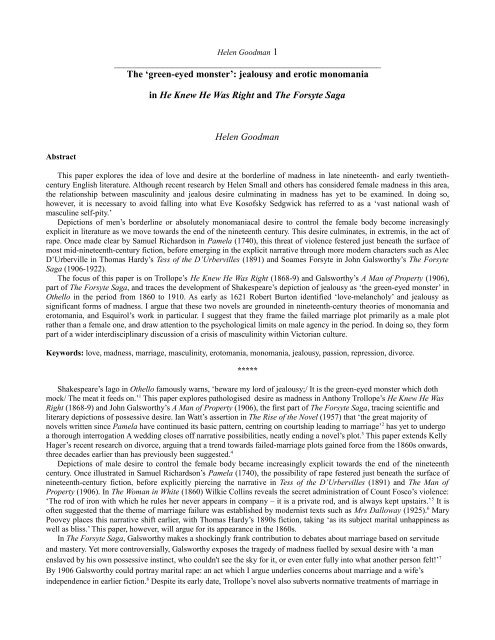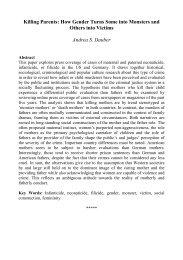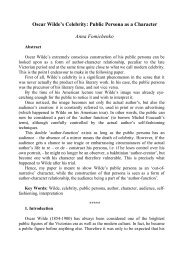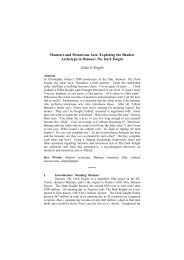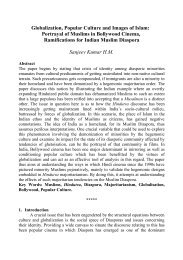The 'green-eyed monster': jealousy and erotic monomania in He ...
The 'green-eyed monster': jealousy and erotic monomania in He ...
The 'green-eyed monster': jealousy and erotic monomania in He ...
You also want an ePaper? Increase the reach of your titles
YUMPU automatically turns print PDFs into web optimized ePapers that Google loves.
Abstract<br />
<strong>He</strong>len Goodman 1<br />
_______________________________________________________<br />
<strong>The</strong> ‘green-<strong>eyed</strong> monster’: <strong>jealousy</strong> <strong>and</strong> <strong>erotic</strong> <strong>monomania</strong><br />
<strong>in</strong> <strong>He</strong> Knew <strong>He</strong> Was Right <strong>and</strong> <strong>The</strong> Forsyte Saga<br />
<strong>He</strong>len Goodman<br />
This paper explores the idea of love <strong>and</strong> desire at the borderl<strong>in</strong>e of madness <strong>in</strong> late n<strong>in</strong>eteenth- <strong>and</strong> early twentiethcentury<br />
English literature. Although recent research by <strong>He</strong>len Small <strong>and</strong> others has considered female madness <strong>in</strong> this area,<br />
the relationship between mascul<strong>in</strong>ity <strong>and</strong> jealous desire culm<strong>in</strong>at<strong>in</strong>g <strong>in</strong> madness has yet to be exam<strong>in</strong>ed. In do<strong>in</strong>g so,<br />
however, it is necessary to avoid fall<strong>in</strong>g <strong>in</strong>to what Eve Kosofsky Sedgwick has referred to as a ‘vast national wash of<br />
mascul<strong>in</strong>e self-pity.’<br />
Depictions of men’s borderl<strong>in</strong>e or absolutely <strong>monomania</strong>cal desire to control the female body become <strong>in</strong>creas<strong>in</strong>gly<br />
explicit <strong>in</strong> literature as we move towards the end of the n<strong>in</strong>eteenth century. This desire culm<strong>in</strong>ates, <strong>in</strong> extremis, <strong>in</strong> the act of<br />
rape. Once made clear by Samuel Richardson <strong>in</strong> Pamela (1740), this threat of violence festered just beneath the surface of<br />
most mid-n<strong>in</strong>eteenth-century fiction, before emerg<strong>in</strong>g <strong>in</strong> the explicit narrative through more modern characters such as Alec<br />
D’Urberville <strong>in</strong> Thomas Hardy’s Tess of the D’Urbervilles (1891) <strong>and</strong> Soames Forsyte <strong>in</strong> John Galsworthy’s <strong>The</strong> Forsyte<br />
Saga (1906-1922).<br />
<strong>The</strong> focus of this paper is on Trollope’s <strong>He</strong> Knew <strong>He</strong> Was Right (1868-9) <strong>and</strong> Galsworthy’s A Man of Property (1906),<br />
part of <strong>The</strong> Forsyte Saga, <strong>and</strong> traces the development of Shakespeare’s depiction of <strong>jealousy</strong> as ‘the green-<strong>eyed</strong> monster’ <strong>in</strong><br />
Othello <strong>in</strong> the period from 1860 to 1910. As early as 1621 Robert Burton identified ‘love-melancholy’ <strong>and</strong> <strong>jealousy</strong> as<br />
significant forms of madness. I argue that these two novels are grounded <strong>in</strong> n<strong>in</strong>eteenth-century theories of <strong>monomania</strong> <strong>and</strong><br />
erotomania, <strong>and</strong> Esquirol’s work <strong>in</strong> particular. I suggest that they frame the failed marriage plot primarily as a male plot<br />
rather than a female one, <strong>and</strong> draw attention to the psychological limits on male agency <strong>in</strong> the period. In do<strong>in</strong>g so, they form<br />
part of a wider <strong>in</strong>terdiscipl<strong>in</strong>ary discussion of a crisis of mascul<strong>in</strong>ity with<strong>in</strong> Victorian culture.<br />
Keywords: love, madness, marriage, mascul<strong>in</strong>ity, erotomania, <strong>monomania</strong>, <strong>jealousy</strong>, passion, repression, divorce.<br />
*****<br />
Shakespeare’s Iago <strong>in</strong> Othello famously warns, ‘beware my lord of <strong>jealousy</strong>;/ It is the green-<strong>eyed</strong> monster which doth<br />
mock/ <strong>The</strong> meat it feeds on.’ 1 This paper explores pathologised desire as madness <strong>in</strong> Anthony Trollope’s <strong>He</strong> Knew <strong>He</strong> Was<br />
Right (1868-9) <strong>and</strong> John Galsworthy’s A Man of Property (1906), the first part of <strong>The</strong> Forsyte Saga, trac<strong>in</strong>g scientific <strong>and</strong><br />
literary depictions of possessive desire. Ian Watt’s assertion <strong>in</strong> <strong>The</strong> Rise of the Novel (1957) that ‘the great majority of<br />
novels written s<strong>in</strong>ce Pamela have cont<strong>in</strong>ued its basic pattern, centr<strong>in</strong>g on courtship lead<strong>in</strong>g to marriage’ 2 has yet to undergo<br />
a thorough <strong>in</strong>terrogation A wedd<strong>in</strong>g closes off narrative possibilities, neatly end<strong>in</strong>g a novel’s plot. 3 This paper extends Kelly<br />
Hager’s recent research on divorce, argu<strong>in</strong>g that a trend towards failed-marriage plots ga<strong>in</strong>ed force from the 1860s onwards,<br />
three decades earlier than has previously been suggested. 4<br />
Depictions of male desire to control the female body became <strong>in</strong>creas<strong>in</strong>gly explicit towards the end of the n<strong>in</strong>eteenth<br />
century. Once illustrated <strong>in</strong> Samuel Richardson’s Pamela (1740), the possibility of rape festered just beneath the surface of<br />
n<strong>in</strong>eteenth-century fiction, before explicitly pierc<strong>in</strong>g the narrative <strong>in</strong> Tess of the D’Urbervilles (1891) <strong>and</strong> <strong>The</strong> Man of<br />
Property (1906). In <strong>The</strong> Woman <strong>in</strong> White (1860) Wilkie Coll<strong>in</strong>s reveals the secret adm<strong>in</strong>istration of Count Fosco’s violence:<br />
‘<strong>The</strong> rod of iron with which he rules her never appears <strong>in</strong> company – it is a private rod, <strong>and</strong> is always kept upstairs.’ 5 It is<br />
often suggested that the theme of marriage failure was established by modernist texts such as Mrs Dalloway (1925). 6 Mary<br />
Poovey places this narrative shift earlier, with Thomas Hardy’s 1890s fiction, tak<strong>in</strong>g ‘as its subject marital unhapp<strong>in</strong>ess as<br />
well as bliss.’ This paper, however, will argue for its appearance <strong>in</strong> the 1860s.<br />
In <strong>The</strong> Forsyte Saga, Galsworthy makes a shock<strong>in</strong>gly frank contribution to debates about marriage based on servitude<br />
<strong>and</strong> mastery. Yet more controversially, Galsworthy exposes the tragedy of madness fuelled by sexual desire with ‘a man<br />
enslaved by his own possessive <strong>in</strong>st<strong>in</strong>ct, who couldn't see the sky for it, or even enter fully <strong>in</strong>to what another person felt!’ 7<br />
By 1906 Galsworthy could portray marital rape: an act which I argue underlies concerns about marriage <strong>and</strong> a wife’s<br />
<strong>in</strong>dependence <strong>in</strong> earlier fiction. 8 Despite its early date, Trollope’s novel also subverts normative treatments of marriage <strong>in</strong>
2 <strong>The</strong> ‘green-<strong>eyed</strong> monster’<br />
__________________________________________________________________<br />
Victorian fiction, present<strong>in</strong>g <strong>monomania</strong> fuelled rather than cured by marriage..<br />
Follow<strong>in</strong>g the fem<strong>in</strong>ist tradition, the failed-marriage plot is widely understood as concerned ‘primarily with the matter of<br />
female agency: it tends to revolve around a wife leav<strong>in</strong>g her husb<strong>and</strong>.’ 9 However, this view is predicated on the assumption<br />
that only female agency is restricted <strong>and</strong> problematized by n<strong>in</strong>eteenth-century marriage laws. I suggest that Trollope frame<br />
the failed-marriage plot primarily as a man’s plot. James Eli Adams has expla<strong>in</strong>ed the critical shy<strong>in</strong>g away from mascul<strong>in</strong>ity<br />
studies: it ‘has been resisted by those concerned that dwell<strong>in</strong>g on the complexities <strong>and</strong> burdens of mascul<strong>in</strong>e identity would<br />
serve to obscure, <strong>and</strong> thereby to re<strong>in</strong>force, the brute realities of male dom<strong>in</strong>ation aga<strong>in</strong>st which fem<strong>in</strong>ist analyses were <strong>and</strong><br />
are <strong>in</strong> the first place directed.’ 10 It also risks fall<strong>in</strong>g <strong>in</strong>to what Eve Kosofsky Sedgwick terms a ‘vast national wash of<br />
mascul<strong>in</strong>e self-pity.’ 11 By exam<strong>in</strong><strong>in</strong>g pathological male desire, <strong>in</strong>herently exacerbat<strong>in</strong>g female repression, this paper beg<strong>in</strong>s<br />
to redress gender imbalances <strong>in</strong> studies of Victorian psychology, illum<strong>in</strong>at<strong>in</strong>g <strong>in</strong>stances of male dom<strong>in</strong>ation, while resist<strong>in</strong>g<br />
the assumption that women were the only ‘victims’ of restricted agency <strong>in</strong> socio-psychological terms.<br />
Trollope’s writ<strong>in</strong>g is deeply rooted <strong>in</strong> n<strong>in</strong>eteenth-century psychological theory, 12 most notably Jean-Étienne Esquirol’s<br />
term ‘<strong>monomania</strong>’, a newly-identified form of <strong>in</strong>sanity. 13 This mania only showed itself when the patient thought or spoke<br />
about one particular subject: an idée fixe. 14 Esquirol’s conceptualisation of <strong>erotic</strong> <strong>monomania</strong> or ‘erotomania’ expla<strong>in</strong>s that<br />
‘ardent affections’, becom<strong>in</strong>g extreme, cause <strong>monomania</strong>cal symptoms. 15 Later def<strong>in</strong>itions described the violent symptoms<br />
shown <strong>in</strong> Galsworthy’s account. John Quackenbos, for <strong>in</strong>stance, writ<strong>in</strong>g a few months after Galsworthy, noted that<br />
erotomania, literally ‘rav<strong>in</strong>g love,’ may rema<strong>in</strong> <strong>in</strong> the imag<strong>in</strong>ation, but may be ‘grossly sensual’, perverted <strong>and</strong> quite<br />
repulsive. 16<br />
Jealousy as a forerunner of madness was explored previously <strong>in</strong> novels such as Charles Reade’s Griffith Gaunt (1866).<br />
Ellen Wood’s sensation novel, St. Mart<strong>in</strong>’s Eve (1866) discussed the theme occurr<strong>in</strong>g <strong>in</strong> a female character. <strong>The</strong> Spectator<br />
reviewed Wood’s novel, compla<strong>in</strong><strong>in</strong>g that madness was trivialised, be<strong>in</strong>g used as a mere plot device, <strong>and</strong> that the author<br />
lacked ‘the power to create Othello, or the art to pa<strong>in</strong>t, as Thackeray or Trollope might have done, the morbid passion <strong>in</strong> its<br />
naturalistic n<strong>in</strong>eteenth-century dress.’ 17 P. D. Edwards suggested that this review, together with Eliza Lynn L<strong>in</strong>ton’s Sow<strong>in</strong>g<br />
the W<strong>in</strong>d from 1867 may have <strong>in</strong>spired Trollope’s to write <strong>He</strong> Knew <strong>He</strong> Was Right. 18 In Trollope’s protagonist the illness<br />
takes an Esquirolian melancholic, relatively chaste form, while Galsworthy’s protagonist, presented <strong>in</strong> this paper as his<br />
literary successor, displays highly sexualised erotomania.<br />
<strong>He</strong> Knew <strong>He</strong> Was Right, the most detailed <strong>and</strong> extended portrait of male <strong>monomania</strong> <strong>in</strong> the Victorian canon, describes<br />
courtship <strong>in</strong> two pages, swiftly skipp<strong>in</strong>g to events two years after their marriage, contrary to Watt’s generalisation.<br />
Suspect<strong>in</strong>g <strong>in</strong>correctly that his wife is conduct<strong>in</strong>g an affair with her ag<strong>in</strong>g godfather, Colonel Osborne, Louis Trevelyan<br />
gradually becomes mad with <strong>jealousy</strong>: a deterioration Trollope repeatedly associates with mascul<strong>in</strong>ity. <strong>He</strong>re Trollope jo<strong>in</strong>s a<br />
contemporary cultural discourse which associated manl<strong>in</strong>ess with good health, physically <strong>and</strong> mentally, perceiv<strong>in</strong>g mental<br />
distress as weakness <strong>in</strong> mascul<strong>in</strong>ity. After Osborne’s first few visits to his wife, Trevelyan struggles with his irrationality:<br />
‘Though he believed himself to be a man very firm of purpose, his m<strong>in</strong>d had oscillated backwards <strong>and</strong> forwards… by some<br />
feel<strong>in</strong>g which pervaded him <strong>in</strong> reference to this man… his powers of m<strong>in</strong>d <strong>and</strong> body were paralysed.’ 19 At the novel’s<br />
open<strong>in</strong>g his agency was maximised, hav<strong>in</strong>g ‘all the world before him where to choose’… a very pearl among men,’ 20 <strong>in</strong><br />
stark contrast to the melancholic hermit, hid<strong>in</strong>g from his wife near Siena a few months later. Trevelyan develops the<br />
symptoms of erotomania described by Esquirol, appear<strong>in</strong>g dejected <strong>and</strong> pale.’ 21 Trollope’s diagnosis is explicit: Trevelyan is<br />
‘mono-maniacal’ 22 <strong>and</strong>, ‘<strong>in</strong> truth, mad on the subject of his wife’s alleged <strong>in</strong>fidelity.’ 23 At Trevelyan’s death bed, his doctor<br />
observes that ‘his patient’s thoughts had been forced to dwell on one subject’, becom<strong>in</strong>g ‘distorted, untrue, jaundiced…<br />
mono-maniacal,’ 24 before the narrator announces that ‘At last the maniac was dead.’ 25<br />
Trollope’s letters reveal that dur<strong>in</strong>g the writ<strong>in</strong>g of <strong>He</strong> Knew <strong>He</strong> Was Right he was <strong>in</strong> communication with psychologists,<br />
collect<strong>in</strong>g material for his fictional case study. Furthermore, there is evidence that this channel of <strong>in</strong>fluence was reciprocal<br />
<strong>in</strong> nature, with doctors read<strong>in</strong>g the novel as pseudo-authentic history of <strong>monomania</strong>. Trollope wrote to one physician, ‘I am<br />
gratified by the attention which your scientific analysis shews that you have given to the character of the unfortunate man
<strong>He</strong>len Goodman 3<br />
_______________________________________________________<br />
which I attempted to draw <strong>in</strong> my novel,’ 26 demonstrat<strong>in</strong>g a two-way traffic of ideas between literary <strong>and</strong> scientific<br />
discipl<strong>in</strong>es. Trollope’s writ<strong>in</strong>g follows psychiatrists who <strong>in</strong>sisted that <strong>monomania</strong> stemmed primarily from personal matters<br />
rather than heredity, such as Forbes W<strong>in</strong>slow <strong>and</strong> J. G. Davey. <strong>The</strong> heightened suspicion <strong>and</strong> physical decl<strong>in</strong>e we observe <strong>in</strong><br />
Trevelyan was central to the new conception of <strong>monomania</strong> as observed by Davey <strong>in</strong> 1855: ‘the vacillat<strong>in</strong>g countenance<br />
<strong>in</strong>dicates the condition of the dismal m<strong>in</strong>d; the eyes sunk <strong>in</strong> their hollow sockets… the looks restless <strong>and</strong> vacant.’ 27<br />
Galsworthy’s <strong>The</strong> Man of Property (1906), set from 1886-7, centres on Soames Forsyte, a wealthy solicitor <strong>and</strong> art<br />
collector, <strong>and</strong> his marriage to the beautiful Irene <strong>He</strong>ron. Galsworthy’s 1922 preface to the complete saga cites ‘possessive<br />
<strong>in</strong>st<strong>in</strong>cts’ <strong>and</strong> a ‘sense of home <strong>and</strong> property’ as his primary concerns. Unlike Trevelyan’s, Forsyte’s suspicions about his<br />
wife’s <strong>in</strong>fidelity are correct. Galsworthy’s publication followed key writ<strong>in</strong>gs on repression by Krafft-Eb<strong>in</strong>g <strong>and</strong> Freud.<br />
Personal violation had been veiled <strong>in</strong>creas<strong>in</strong>gly th<strong>in</strong>ly <strong>in</strong> the fiction of preced<strong>in</strong>g decades. <strong>The</strong> possibility of sexual violence<br />
haunts the narrative of sensation fiction on madness from the early 1860s. For D. A. Miller, rape can be figured as what<br />
Rol<strong>and</strong> Barthes terms the ‘symbolic mode’ of <strong>The</strong> Woman <strong>in</strong> White. This vague fear is present dur<strong>in</strong>g Anne <strong>and</strong> Walter’s<br />
first encounter, <strong>and</strong> later ‘what Fosco f<strong>in</strong>ally accomplishes when he reads Marian’s journal <strong>in</strong>time – is virtual rape.’ 28<br />
<strong>The</strong> Forsyte Saga’s later date enabled Galsworthy to expose what had been implied <strong>in</strong> earlier fiction. Although Irene’s<br />
rape takes place outside narrative space, we cannot doubt what the ‘<strong>in</strong>cident of the night before’ entailed. 29 <strong>The</strong> sight <strong>and</strong><br />
sounds which haunt Soames afterwards are described with a sear<strong>in</strong>g clarity that was almost unth<strong>in</strong>kable for earlier writers.<br />
Galsworthy ironically writes, ‘<strong>The</strong> morn<strong>in</strong>g after a certa<strong>in</strong> night on which Soames at last asserted his rights <strong>and</strong> acted like a<br />
man, he breakfasted alone,’ 30 plagued by doubt. 31<br />
Had he been right to yield to his overmaster<strong>in</strong>g hunger… the recollection of her face… her terrible smothered<br />
sobb<strong>in</strong>g… he was still haunted by the odd, <strong>in</strong>tolerable feel<strong>in</strong>g of remorse <strong>and</strong> shame he had felt, as he stood<br />
look<strong>in</strong>g at her by the flame of the s<strong>in</strong>gle c<strong>and</strong>le, before silently sl<strong>in</strong>k<strong>in</strong>g away. 32<br />
This assertion of legal rights is reconfigured by Soames’s guilt-wracked m<strong>in</strong>d as a violent crime, utterly <strong>in</strong>compatible with<br />
his self-identity. <strong>He</strong>ar<strong>in</strong>g from his housekeeper that Irene has left him, Soames’s state deteriorates. ‘<strong>The</strong> words “no message<br />
– a trunk, <strong>and</strong> a bag,” played hide-<strong>and</strong>-seek <strong>in</strong> his bra<strong>in</strong>.’ 33 <strong>He</strong> feels his ‘bra<strong>in</strong> go<strong>in</strong>g round,’ tears ‘forced themselves <strong>in</strong>to his<br />
eyes,’ <strong>and</strong> ‘the burn<strong>in</strong>g sickness of his <strong>jealousy</strong> seized him aga<strong>in</strong>… His power of decision aga<strong>in</strong> failed.’ 34 Galsworthy<br />
dissects idealised male attributes of emotional restra<strong>in</strong>t <strong>and</strong> rational decisiveness, twist<strong>in</strong>g them with irony. Soames’s most<br />
decisive <strong>and</strong> apparently manly act is antithetical to the ideals of happy companionate marriage <strong>and</strong> gentlemanl<strong>in</strong>ess to which<br />
he aspires.<br />
<strong>The</strong> madmen <strong>in</strong> Trollope <strong>and</strong> Galsworthy’s novels represent a disturb<strong>in</strong>g threat of violent attack com<strong>in</strong>g from with<strong>in</strong> the<br />
domestic space, contribut<strong>in</strong>g to a cultural re-evaluation of mascul<strong>in</strong>e identity towards the f<strong>in</strong> de siècle. By identify<strong>in</strong>g the<br />
failed marriage plot’s emergence as early as the 1860s <strong>and</strong> read<strong>in</strong>g the failed-marriage plot <strong>in</strong> mascul<strong>in</strong>e terms, this paper<br />
has exposed crucial difficulties <strong>in</strong> male agency, caus<strong>in</strong>g a crisis of agency for Victorian normative gentlemanl<strong>in</strong>ess.<br />
Representations of marital breakdown, erotomania, domestic violence <strong>and</strong> marital rape are crucial aspects of the failure of<br />
idealised domesticity, <strong>and</strong> illustrate the extensive heterogeneity of Victorian marriages. Such depictions rupture ideologies<br />
of domestic perfection, <strong>and</strong> present strong opposition to the traditional perception of the dom<strong>in</strong>ance of companionate<br />
marriage plots.<br />
Notes
1 Shakespeare, Othello, III.iii. l. 165-7.<br />
2 Ian Watt, <strong>The</strong> Rise of the Novel: Studies <strong>in</strong> Defoe, Richardson <strong>and</strong> Field<strong>in</strong>g (Harmondsworth:<br />
Pengu<strong>in</strong>, 1970), 154.<br />
3 D. A. Miller has argued that novels end<strong>in</strong>g <strong>in</strong> happy marriages, like Jane Austen’s, ‘<strong>in</strong>hibit narrative<br />
productivity.’ Emma <strong>and</strong> Mr Knightley’s marriage, for <strong>in</strong>stance, ‘must end the novel…otherwise, it<br />
would not be a “perfect” union.’<br />
Narrative <strong>and</strong> Its Discontents (Pr<strong>in</strong>ceton, New Jersey: Pr<strong>in</strong>ceton University Press, 1981), 4.<br />
4 Kelly Hager, Dickens <strong>and</strong> the Rise of Divorce: <strong>The</strong> Failed-Marriage Plot <strong>and</strong> the Novel Tradition<br />
(Farnham, Surrey: Ashgate, 2010).<br />
5 Wilkie Coll<strong>in</strong>s, <strong>The</strong> Woman <strong>in</strong> White (Ware, <strong>He</strong>rtfordshire: Wordsworth, 1993), 174.<br />
6 For example, Emily Blair argues for a different area of cont<strong>in</strong>uity from Victorian novelists to Woolf,<br />
<strong>and</strong> writes that ‘Woolf’s depiction of fem<strong>in</strong><strong>in</strong>ity resonates with the depictions of Gaskell <strong>and</strong> Oliphant<br />
as she simultaneously re<strong>in</strong>vents the novel <strong>and</strong> revises the marriage plot.’ Virg<strong>in</strong>ia Woolf <strong>and</strong> the<br />
N<strong>in</strong>eteenth-century Domestic Novel (Albany: State of New York Press, 1997), 9.<br />
7 John Galsworthy, In Chancery, <strong>The</strong> Forsyte Saga (Oxford: Oxford University Press, 2008), 514.<br />
8 Just fifteen years before the publication of this section of the saga, Hardy’s Tess of the D’Urbervilles<br />
sc<strong>and</strong>alised readers with its portrayal of the raped woman as a morally pure victim. Galsworthy’s Irene<br />
is similarly <strong>in</strong>nocent of all blame for the violence she experiences.<br />
9 Hager, Dickens <strong>and</strong> the Rise of Divorce, 8.
10 James Eli Adams. D<strong>and</strong>ies <strong>and</strong> Desert Sa<strong>in</strong>ts (Ithaca, New York: Cornell University Press, 1995), 3.<br />
11 Eve Kosofsky Sedgwick. Epistemology of the Closet (Berkeley <strong>and</strong> Los Angeles: University of<br />
California Press, 1992), 145).<br />
12 This field of psychology was not, however, a new one. In 1621 Robert Burton identified ‘lovemelancholy’<br />
<strong>and</strong> <strong>jealousy</strong> as significant forms of madness.<br />
13 Jean-Étienne Esquirol, Mental Maladies; a Treatise on Insanity (Philadelphia: Lea <strong>and</strong><br />
Blanchard, 1845).<br />
Other medics of the period were broadly <strong>in</strong> agreement with Esquirol’s outl<strong>in</strong>es. In J. C. Prichard’s <strong>in</strong>fluential treatise (1837)<br />
he def<strong>in</strong>ed <strong>monomania</strong> as a form of <strong>in</strong>sanity ‘<strong>in</strong> which the underst<strong>and</strong><strong>in</strong>g is partially disordered or under the <strong>in</strong>fluence of<br />
some particular illusion, referr<strong>in</strong>g to one subject.’ A Treatise on Insanity <strong>and</strong> Other Disorders Affect<strong>in</strong>g the M<strong>in</strong>d (New<br />
York: Arno Press, 1973), 16.<br />
14 <strong>The</strong> Oxford English Dictionary notes that 1897 the term ‘<strong>monomania</strong>’ had become outdated.<br />
15 Esquirol, Mental Maladies, 335.<br />
16 John Quackenbos, ‘Erotomania, Infatuation, Moral Perversion’, Hypnotic <strong>The</strong>rapeutics <strong>in</strong> <strong>The</strong>ory<br />
<strong>and</strong> Practice (n.p.: Harper <strong>and</strong> Brothers, 1908), 201.<br />
17 Anon, <strong>The</strong> Spectator (3 February 1866), 135.<br />
18 P. D. Edwards, Anthony Trollope: His Art <strong>and</strong> Scope (Hassock: Harvester Press, 1966), 115.
19 Trollope, <strong>He</strong> Knew <strong>He</strong> Was Right, 23.<br />
20 Trollope, <strong>He</strong> Knew <strong>He</strong> Was Right, 9. Trollope quotes from Paradise Lost, xii.<br />
21 Jean-Étienne Esquirol, trans. E. A. Hunt, Mental Maladies; a treatise on <strong>in</strong>sanity (Philadelphia: Lea<br />
<strong>and</strong> Blanchard, 1845), 336.<br />
22 Ibid., 796.<br />
23 Trollope, <strong>He</strong> Knew <strong>He</strong> Was Right, 325.<br />
24 Ibid., 796.<br />
25 Ibid., 820.<br />
26 N. John Hall, ed. Letters of Anthony Trollope vol. II (Stanford: Stanford University Press, 1983),<br />
1011.<br />
27 J. G. Davey, ‘Lectures on Insanity, Delivered at the Bristol Medical School Dur<strong>in</strong>g the Summer<br />
Session of 1855: Lecture II’, <strong>The</strong> British Medical Journal (20 July 1855), 674.<br />
28 D. A. Miller, ‘Cage aux folles: Sensation <strong>and</strong> Gender <strong>in</strong> Wilkie Coll<strong>in</strong>s’s <strong>The</strong> Woman <strong>in</strong> White’, <strong>in</strong><br />
<strong>The</strong> Mak<strong>in</strong>g of the Modern Body: Sexuality <strong>and</strong> Society <strong>in</strong> the N<strong>in</strong>eteenth Century, ed. by Cather<strong>in</strong>e<br />
Gallagher <strong>and</strong> Thomas Lacqueur (London: University of California Press, 1987), 116.
Marian is ‘firmly ab<strong>and</strong>oned by Walter’s <strong>erotic</strong> <strong>in</strong>terest <strong>and</strong> forcibly seduced by Fosco’s… perhaps the<br />
most important fantasy feature of rape is the reaffirmation of the rapist’s unimpaired capacity to<br />
withdraw, the <strong>in</strong>tegrity of his body (if not his victim’s) recovered <strong>in</strong>tact. (Fosco, we recall, returns to<br />
Marian the journal he has <strong>in</strong>delibly signed, <strong>and</strong> she, eventually, is stuck with it.)’<br />
D. A. Miller, <strong>The</strong> Novel <strong>and</strong> the Poice (Berkeley <strong>and</strong> Los Angeles: University of California Press,<br />
1988), 181.<br />
Hardy also considers this k<strong>in</strong>d of impr<strong>in</strong>t left by rape, question<strong>in</strong>g why Tess Durbeyfield should have<br />
been so doomed: ‘Why it was that upon this beautiful fem<strong>in</strong><strong>in</strong>e tissues, sensitive as gossamer, <strong>and</strong><br />
practically blank as snow yet, there should have been traced such a coarse pattern as it was doomed to<br />
receive.’ Tess of the D’Urbervilles (London: Pengu<strong>in</strong>, 2003).<br />
29 Galsworthy, <strong>The</strong> Forsyte Saga, 253.<br />
30 Ibid., 249<br />
31 Ibid., 251.<br />
32 Galsworthy, <strong>The</strong> Forsyte Saga, 250.<br />
33 Galsworthy, <strong>The</strong> Forsyte Saga, 271.<br />
34 Ibid., 271.<br />
Bibliography<br />
Adams, James Eli. D<strong>and</strong>ies <strong>and</strong> Desert Sa<strong>in</strong>ts (Ithaca, New York: Cornell University Press, 1995).
Anon, ‘Madness <strong>in</strong> Novels,’ <strong>The</strong> Spectator 3 Feb., 1866.<br />
Blair, Emily. Virg<strong>in</strong>ia Woolf <strong>and</strong> the N<strong>in</strong>eteenth-century Domestic Novel (Albany: State of New York<br />
Press, 1997).<br />
Burton, Robert. <strong>The</strong> Anatomy of Melancholy (New York: New York Review of Books, 2001).<br />
Castronovo, David. <strong>The</strong> English Gentleman: Images <strong>and</strong> Ideals <strong>in</strong> Literature <strong>and</strong> Society (New York:<br />
Ungar, 1987).<br />
Coll<strong>in</strong>s, Wilkie. <strong>The</strong> Woman <strong>in</strong> White (Ware, <strong>He</strong>rtfordshire: Wordsworth, 1993).<br />
Davey, J. G. Davey, ‘Lectures on Insanity, Delivered at the Bristol Medical School Dur<strong>in</strong>g the Summer<br />
Session of 1855: Lecture II’, <strong>The</strong> British Medical Journal (20 July 1855).<br />
Edwards, P. D. Anthony Trollope: His Art <strong>and</strong> Scope (Hassock: Harvester Press, 1966).<br />
Esquirol, Jean-Étienne, Mental Maladies; a Treatise on Insanity (Philadelphia: Lea <strong>and</strong><br />
Blanchard, 1845).<br />
Freud, Sigmund. <strong>The</strong> Psychopathy of Everyday Life (London: Pengu<strong>in</strong>, 2002).<br />
Frost, G<strong>in</strong>ger S. Liv<strong>in</strong>g <strong>in</strong> S<strong>in</strong>: Cohabit<strong>in</strong>g as Husb<strong>and</strong> <strong>and</strong> Wife <strong>in</strong> N<strong>in</strong>eteenth-Century Engl<strong>and</strong><br />
(Manchester <strong>and</strong> New York: Manchester University Press, 2008).<br />
Gallagher, Cather<strong>in</strong>e <strong>and</strong> Thomas Lacqueur, eds., <strong>The</strong> Mak<strong>in</strong>g of the Modern Body: Sexuality <strong>and</strong><br />
Society <strong>in</strong> the N<strong>in</strong>eteenth Century (London: University of California Press, 1987).
Galsworthy, John. <strong>The</strong> Forsyte Saga (Oxford: Oxford University Press, 2008).<br />
Hager, Kelly. Dickens <strong>and</strong> the Rise of Divorce: <strong>The</strong> Failed-Marriage Plot <strong>and</strong> the Novel Tradition<br />
(Farnham, Surrey: Ashgate, 2010)<br />
Hall, John N., ed. Letters of Anthony Trollope vol. II (Stanford: Stanford University Press, 1983).<br />
Hardy, Thomas. Tess of the D’Urbervilles (London: Pengu<strong>in</strong>, 2003).<br />
Krafft-Eb<strong>in</strong>g, Richard von. Psychopathia Sexualis (New York: Arcade, 1965).<br />
L<strong>and</strong>els, William. <strong>The</strong> Marriage R<strong>in</strong>g: A Gift-Book for the Newly-Married <strong>and</strong> for Those<br />
Contemplat<strong>in</strong>g Marriage (London, Paris <strong>and</strong> New York: Cassell, Petter, Galph<strong>in</strong> & Co., 1883).<br />
Langl<strong>and</strong>, Elizabeth. ‘Nobody's Angels: Domestic Ideology <strong>and</strong> Middle-Class Women <strong>in</strong> the Victorian<br />
Novel’, PMLA, vol. 107, no. 2 (March 1992), 290-304.<br />
L<strong>in</strong>ton, Eliza Lynn. Sow<strong>in</strong>g the W<strong>in</strong>d (London: T<strong>in</strong>sley Brothers, 1867).<br />
Markwick, Margaret, Deborah Denenholz Morz <strong>and</strong> Regenia Gagnier, eds. <strong>The</strong> Politics of Gender <strong>in</strong><br />
Anthony Trollope’s Novels (Farnham, Surrey: Ashgate, 2009).<br />
Miller, D. A. Narrative <strong>and</strong> Its Discontents (Pr<strong>in</strong>ceton, New Jersey: Pr<strong>in</strong>ceton University Press, 1981).<br />
---, <strong>The</strong> Novel <strong>and</strong> the Police (Berkeley <strong>and</strong> Los Angeles: University of California Press, 1988).<br />
Poovey, Mary. ‘Recover<strong>in</strong>g Ellen Picker<strong>in</strong>g’, Yale Journal of Criticism 13 (2000), 437-52.
Prichard, James Cowles. A Treatise on Insanity <strong>and</strong> Other Disorders Affect<strong>in</strong>g the M<strong>in</strong>d (New York:<br />
Arno Press, 1973).<br />
Quackenbos, John. ‘Erotomania, Infatuation, Moral Perversion’, Hypnotic <strong>The</strong>rapeutics <strong>in</strong> <strong>The</strong>ory <strong>and</strong><br />
Practice (n.p.: Harper <strong>and</strong> Brothers, 1908).<br />
Reade, Charles. Griffith Gaunt; or, Jealousy (New York: Harper <strong>and</strong> Brothers, 1873).<br />
Richardson, Samuel. Pamela; or, Virtue Rewarded (Oxford: Oxford University Press, 2001).<br />
Shakespeare, William. As You Like It (Oxford: Oxford University Press, 2008).<br />
---, Othello (Oxford: Oxford University Press, 2008).<br />
Tosh, John. A Man’s Place: Mascul<strong>in</strong>ity <strong>and</strong> the Middle-Class Home <strong>in</strong> Victorian Engl<strong>and</strong> (New Haven<br />
<strong>and</strong> London: Yale University Press, 2007).<br />
Trollope, Anthony. <strong>He</strong> Knew <strong>He</strong> Was Right (London: Pengu<strong>in</strong>, 2004).<br />
Watt, Ian. <strong>The</strong> Rise of the Novel: Studies <strong>in</strong> Defoe, Richardson <strong>and</strong> Field<strong>in</strong>g (Harmondsworth: Pengu<strong>in</strong>,<br />
1970).<br />
Wiener, Mart<strong>in</strong> L., Men of Blood: Violence, Manl<strong>in</strong>ess, <strong>and</strong> Crim<strong>in</strong>al Justice <strong>in</strong> Victorian Engl<strong>and</strong><br />
(Cambridge: Cambridge University Press, 2007).<br />
Wood, Ellen. St. Mart<strong>in</strong>’s Eve (London: T<strong>in</strong>sley Brothers, 1866).
<strong>He</strong>len Goodman is a PhD student <strong>in</strong> the English Department at Royal Holloway, University of<br />
London. <strong>He</strong>r thesis on madness <strong>and</strong> mascul<strong>in</strong>ity <strong>in</strong> Victorian literature <strong>and</strong> culture comb<strong>in</strong>es research<br />
on fiction, the popular press, medical writ<strong>in</strong>gs <strong>and</strong> archived medical records from lunatic asylums <strong>in</strong><br />
the London area.


